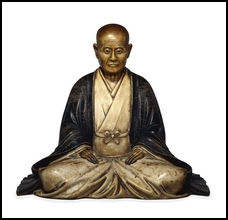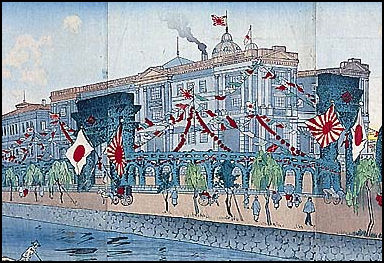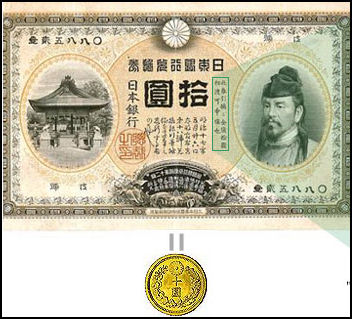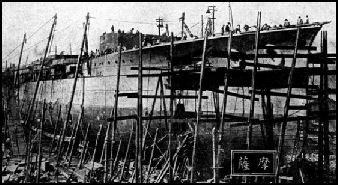ECONOMIC HISTORY OF JAPAN BEFORE THE 1970s

Chinese coin found
in Japan dated to 221 B.C. Chinese money was introduced to Japan about 1,500 years ago. The first Japanese coins were minted from copper and silver in A.D. 708. Paper money was introduced in 1661. The oldest minted coins were unearthed at the ancient site of Fujiwarakyu, the ancient capital of Japan from 694 to 710, in Kashihara, Nara.
From the 12th century to the 17th century, Japan was dominated by a delicately-balanced, feudal-military system led by daimyos who controlled competing semi-autonomous domains. Daimyos were essentially warlords whose power was based on the strength of their private armies. They rose from a class of rural military chieftains and lived like rich feudal lords. There were about 260 daimyo at the peak of their power.
Japanese kingdoms were often in valleys or sections of coastline divided up by Japan's rough topography. Wealth was measured in koku of rice. One koku was equal to five bushels, 39.7 gallons or 180.4 liters. and was regarded as the amount of rice needed to feed one person for one year. A large fiefdom yielded about 1.2 million koku of rice, with the annual salary of an important lord being around 500,000 koku.
Ordinary people in feudal times had few rights and were subject to the whims and wishes of the ruling samurai and their lords. Even so Japanese peasants were better off than European serfs. They retained some rights to their land and for the most were spared excessive taxation.
RELATED ARTICLES IN THIS WEBSITE: MODERN HISTORY factsanddetails.com; ECONOMIC HISTORY factsanddetails.com; JAPAN AFTER WORLD WAR II: HARDSHIPS, MACARTHUR, THE AMERICAN OCCUPATION AND REFORMS factsanddetails.com; JAPAN'S POST-WORLD-WAR II ECONOMY AND THE ECONOMIC MIRACLE OF THE 1950s AND 60s factsanddetails.com; JAPAN INTHE 1950s, 60s AND 70s UNDER YOSHIDA, IKEDA, SATO AND TANAKA factsanddetails.com; JAPAN BECOMES AN ECONOMIC POWERHOUSE IN THE 1970s AND 80s factsanddetails.com; JAPAN IN THE 1980s AND EARLY 1990s: NAKASONE AND THE PRIME MINISTERS THAT FOLLOWED HIM factsanddetails.com; JAPANESE BUBBLE ECONOMY IN THE 1980s AND ITS COLLAPSE IN THE 1990s factsanddetails.com; RECESSION, DEFLATION AND DECLINE FOLLOWING JAPAN'S BUBBLE ECONOMY COLLAPSE factsanddetails.com; JAPAN AND ITS PRIME MINISTERS AND GOVERNMENT IN THE 1990s AND EARLY 2000s factsanddetails.com; JUNICHIRO KOIZUMI factsanddetails.com; ECONOMIC REFORMS AND RECOVERY IN THE 2000s IN JAPAN factsanddetails.com; JAPAN, THE GLOBAL ECONOMIC CRISIS IN 2008 AND AFTERWARDS: HARD TIMES, STIMULUS AND SLIGHT RECOVERY factsanddetails.com; IMPACT OF THE MARCH 2011 EARTHQUAKE AND TSUNAMI ON THE JAPANESE ECONOMY, FACTORIES AND COMPANIES factsanddetails.com; ECONOMY AFTER THE MARCH 2011 TSUNAMI: RECOVERY AND SLOWDOWN IN 2012 factsanddetails.com; JAPAN'S DECLINE factsanddetails.com ABENOMICS: SHINZO ABE’S POLICIES TO TURN THE JAPANESE ECONOMY AROUND factsanddetails.com; SUCCESSES OF ABENOMICS factsanddetails.com; ABENOMICS OBSTACLES AND FAILURES factsanddetails.com
Websites and Resources

17th century statue of a merchant Good Websites and Sources: Economic History and Economy of Japan applet-magic.com ; Google E-Book: Economic History of Japan 1600-1990 books.google.com/books ; Google E-Book: Emergence of Economic Society in Japan 1600-1990 books.google.com/books ; Economic History Links let.leidenuniv.nl/history
Economic Miracle After World War II: Wikipedia article Wikipedia ; Jref Article wa-pedia.com ; Long Blog Report dostoevskiansmiles.blogspot.com ; Yale Paper on the Economic Miracle econ.yale.edu ; Book on The Economic Miracle amazon.com/Allied-Occupation-Japans-Economic-Miracle ; Essay on Japan’s Rebirth at the 1964 Olympics aboutjapan.japansociety.org ; Essay on Age of the Middle Class aboutjapan.japansociety.org
Good Websites and Sources on Economics: Ministry of Economy, Trade and Industry meti.go.jp/english ; Ministry of Finance of Japan mof.go.jp/english ; Japan Economy News and Blog japaneconomynews.com ; Japan Economy Watch japanjapan.blogspot.com ; Japan Center for Economic Research jcer.or.jp/eng ; Japan Inc. Economic and Business News japaninc.com ; Google E-Book: Japan in the 21st Century, Environment, Economy and Society (2005) books.google.com/books
World’s Oldest Company
In Japan there are more than 100,000 companies that have been in business for more than a century. There are over 100 that have been in operation since the 14th century.
The world’s oldest company is the Osaka-based, construction firm Kongo Gumi. Owned and operated by the Kongo family since A.D. 578, a century after the fall of Roman empire, it has survived feudal wars, earthquakes and the bursting of the bubble economy. Its first job — the construction of the Shitennoji temple in Namba, Osaka — was in A.D. 593. It racked up sales of $85 million in 2001. Its CEO is from a 40-generation family line.
The secret to Kongo Gumi’s success, its owners say, has been staying focused on what it has done best over the centuries: building Buddhist temples and Shinto shrines. But at the same it has not shied away from innovations. The company was one of the first in its field to use concrete instead of wood and employ computer-aided designs.
Economy in the Edo Period

The long period of peace during the Edo Period (1603-1867) allowed economic growth to take place. The merchant class grew and prospered. An early consumer society took hold. There were lots of street vendors, selling all sorts of things. Craftsmen were able to find buyers for their products. Tea shops and restaurants opened as people began to eat out more.
As the merchant class grew richer their power grew. As the daimyo grew poorer they lost their power. By the 1800s, the revenues a once powerful daimyo made from selling rice was about that of a single kimono shop in Tokyo. The samurai under the daimyos became impoverished and had to seek other lines of work, such as working as policemen and craftsmen. Many were forced to beg or sell their swords to eat.
Cheaper varieties of lamp oil became available and people stay up later at night. The distribution of sugar was increased and a large variety of confectionaries became available.
People read bestselling books and bought name brand items. “Yuzen-zome” dyed textiles were highly sought after in the 18th century. Even though Japan was largely closed to outsiders, wealthy Japanese greatly desired cloth made from foreign materials. There were entire quarters devoted to the needs of wealthy samurai and rising merchants. Men who could afford it indulged themselves with things like silk underwear with red and white flowers.
One of the most respected figures today from the Edo period is Uesugi Yozan, a feudal lord in what is now Yamagata Prefecture. He is credited with turning his debt-ridden domain into one of the most productive regions in Japan by developing new rice paddy fields, cultivating lacquer trees and safflower, and encouraging samurai to take up farming. He is famous for implementing belt-tightening measures such as recommending that people eat simple meals and wear cotton clothes. He described his policies and reasoning behind them in “Denkoku no Ji”, a book on how feudal lords should think and behave. In moderns Japan this book and Uesugi’s ideas and methods has drawn the interest of business executives and local administrators and bureaucrats.
Echigo-ya, the World's First Large-Scale Retailer
Echigo-ya, a kimono store that was the predecessor of Mitsukoshi department store, was the world's first large-scale retailer and the biggest store throughout the 18th century, according to a study by Japanese and French scholars. According to an article published in the Yomiuri Shimbun, “ Echigo-ya started business in Edo, today's Tokyo, in 1673 during the Edo period (1603-1867). The latest discovery was made by Tsunehiko Yui, a researcher of business history and the curator of Mitsui Bunko, or Mitsui Archives. [Source: Yomiuri Shimbun, February 4, 2013 ***]

Ukiyo-e of Bank of Japan “Mitsui Bunko is known for its vast collection of historical business records and its research of such records related to the Mitsui family business conglomerate. In comparing the records of Echigo-ya with those from Europe and other regions, Yui confirmed the store's annual sales in the 18th century were equivalent to about 10 billion yen in today's terms. It also boasted one of the world's largest workforces and ground area at the time. The shop employed at least 300 people and occupied an area up to about 2,400 square meters. The recent study was conducted jointly with Prof. Patrick Fridenson of France's state-run School for Advanced Studies in the Social Sciences, who is also a researcher of business history. The results of the two scholars' research were presented at the Japan-France business management history conference. ***
“Echigo-ya introduced a new sales formula in Japan of "cash payment, no discounts and no markups," in its sales of kimono and other merchandise to a wide range of ordinary people. The shop's business grew rapidly. According to ledgers stored at Mitsui Bunko, in the 10-year period from 1739, Echigo-ya's annual sales amounted to 200,000 ryo. One ryo is equivalent to between 40,000 yen and 60,000 yen today.According to Fridenson, who specializes in comparing business management history across nations, Europe's storefront retailers developed in the 18th century but on a smaller scale.Thus they concluded there was no retail establishment on the same scale as Echigo-ya during the time period. ***
“The researchers said it was not until the 19th century when such large-scale retailers as French department stores Le Bon Marche and Printemps appeared on the continent. Yui said: "In the 18th century, people talked about Paris or London as the center of the world economy. But Edo had already developed as one of the world's largest cities with a population of nearly 1 million. I assume the development of traffic networks and a growing number of consumers also contributed to the growth of large-scale retailers." ***
Economic Changes in Japan in the 1850s

1899 10 yen banknote and coin Perry’s first visit to Japan in 1853 caused great economic changes as well as social upheaval. With the opening of the nation to exports, prices of major exports such as raw silk quadrupled at once. As the gold-silver exchange rates in Japan and abroad differed, an exodus of Japanese gold occurred. The reminting of koban — a Japanese gold coin of the Edo period (1603-1867)’spurred hyperinflation.
Riding the tide of trade liberalization, newly emerging merchants came to the fore, while long-established wholesalers in Tokyo and Osaka lost their monopoly on the distribution of goods. These developments can be likened to the implementation of trade liberalization, currency devaluation, distribution system reform and regulatory reform all at once. Although the country's economy became chaotic, these major changes did lay the foundations for the rapid modernization of Japan's economy.
Meiji Period Economy
The Japanese feudal system was peacefully dissolved in 1868 and 1869, with the reformist government overseeing the buying up of land owned by daimyos, who were incorporating into the new imperial aristocracy. Daimyo land was divided into the prefectures that still exist today.
Japan resisted the power and hegemony of the West by emulating the West. Under the slogan "rich country, strong military," the Japanese government was intent on learning the secrets of the West and Western experts were brought to Japan and Japanese experts were sent abroad to learn everything they could.
When Japan began to modernize after the Meiji Restoration it produced only one major product for export: silk. By using machinery to both upgrade the quality and quantity of silk produced Japan became the world’s largest exporter of silk in 1909. Much of the foreign currency earned from silk was used to beef up the Japanese navy.
Zaibatsu
By 1925 most small industries had been crushed by monopolies of giant corporations headed by extremely powerful and rich families. These giant corporations, known as “zaibatsu”, dominated the Japanese economy until the end of World War II.
Powerful zaibatsu families included the Mitsuis, the Iwasakis (Mitsubishi), the Yasudas and Kichizaemon Sumitomo. The Mitsubishi conglomerate was founded by Iwasaki Yataro, born near Kochi on Shikoku in 1834.
The Sumitomo family of 600 firms included Sumitomo Corp., Sumitomo Heavy Industries, Sumitomo Bank, Sumitomo Chemical, Sumitomo Electric Industry, Sumitomo Trust and Banking, Sumitomo Rubber and NEC.
Sumitomo was founded in the 17th century by a warrior monk named Masatomo Sumitomo, who gave up the monastic life and opened up a medicine shop and bookstore and later expanded into copper after Sumitomo leaned European copper refining techniques and acquired a copper mine on the island of Shikoku.
Japanese Economy Before World War II

In the early 20th century Japan grow into a major industrial-military power. Between 1921 and 1937 Japans puts it factories into high gear and produced six large aircraft carries and the world's largest and best equipped air force. Japan's zaibatsu capitalists were blamed for stirring up militarism and nationalism and suppressing democracy to make money.
In the 1930s the command economy was oriented toward meeting the needs of the military and military spending was the largest single budget item.
Image Sources: 1) 4) 5) Currency Museum of the Bank of Japan 2) British Museum 3) Wikipedia 8) Sony 9) Toyota 10), 11) Kantei, office of prime minister 12) Honda
Text Sources: New York Times, Washington Post, Los Angeles Times, Daily Yomiuri, Times of London, Japan National Tourist Organization (JNTO), National Geographic, The New Yorker, Time, Newsweek, Reuters, AP, Lonely Planet Guides, Compton’s Encyclopedia and various books and other publications.
Last updated January 2014
